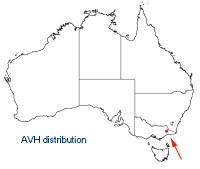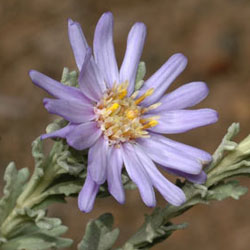Olearia astroloba
Marble Daisy Bush
Olearia astroloba Lander & N.G.Walsh
Olearia astroloba , or ‘Marble Daisy Bush’ is rare in the wild, but is extremely well adapted to cultivation. It belongs to the Asteraceae, best known as the ‘daisy family’, and has the star-shaped flowers common to the group. Olearia species are well suited to gardens as they are fast-growing and most flower profusely throughout the year. They are usually shrubs and are often covered in pink, white, blue or mauve daisy flowers.
There are 189 species of Olearia, 130 of them endemic to Australia. The Marble Daisy Bush, Olearia astroloba, was first described in 1989 by Lander and Walsh, so is relatively new to science.
Olearia astroloba grows as a shrub roughly 1 m high and 2 m in diameter. The leaves are alternate, sessile and hairy and are closely crowded on the stem. They are greyish green to silvery grey. The ray florets of the inflorescences (what appear to be the petals) are blue to violet, and the disc florets which form the centre of the ‘flower’ are yellow and blue.
 In the wild, Olearia astroloba is restricted to a small area (around 40 hectares) in the East Gippsland area of Victoria, near the Tambo Valley, called Marble Gully. This is the origin of the common name ‘Marble Daisy Bush’. The species is listed as rare, and in the wild consists of a single population of fewer than 1000 individuals.
In the wild, Olearia astroloba is restricted to a small area (around 40 hectares) in the East Gippsland area of Victoria, near the Tambo Valley, called Marble Gully. This is the origin of the common name ‘Marble Daisy Bush’. The species is listed as rare, and in the wild consists of a single population of fewer than 1000 individuals.
Marble Daisy Bush can be propagated from either cuttings or seed. However, only a low proportion of seeds are viable (dark brown seed pods are more likely to be fertile), so cuttings are more reliable. The plant grows well in full sun or in shade and does particularly well on slopes, which mimics its natural habitat. It prefers free-draining alkaline soil, but can survive well in soil with little special preparation. As with other plants in the Olearia genus, the marble daisy bush benefits from pruning. This encourages new growth, including new flowers. It can resprout from the base, making it a hardy, resilient plant. The peak flowering period is from June to November, but it can flower throughout the year, especially after rain. The species is extremely drought tolerant, and has thrived for many years in areas of the Australian National Botanic Gardens that receive no extra watering.
Olearia astroloba has no known pests or diseases (although it is new to cultivation and has not been extensively studied). It is frost tolerant, and lives for at least ten years. It will grow happily in garden beds or even in pots. By cultivating this plant, you will help to ensure the survival of one of Australia’s rarest and most interesting species.
Text by Nicole Busby (2007 Botanical Intern)
Name Meaning: Olearia astrolobaOlearia – named in honour of German botanist, J.G.Oelschlaeger (1635-1711) [Latinised as Olearius]; astroloba – from astro (star-shaped) and loba (lobes), referring to the stellate (star-shaped) hairs on the lobes of the disc florets. |
References
Baines, J. A. (1981). Australian Plant Genera: An Etymological Dictionary of Australian Plant Genera. Sydney: Society for Growing Australian Plants .
Carter, O. and Walsh, N. (2006). National Recovery Plan for the Marble Daisy-bush Olearia astroloba. Melbourne: Department of Sustainability and Environment, Victoria.
Clarke, I. and Lee, H. (2003) .Name that Flower: The Identification of Flowering Plants (second edition). Melbourne: Melbourne University Press .
Downe, J. and Coates, F. (2004) . Recovery of Silurian limestone Pomaderris shrubland after the 2003 bushfires in north-east Victoria. Arthur Rylah Institute for Environmental Research Technical Series Report No. 151. Melbourne: Department of Sustainability and Environment, Victoria.
Elliot, W. R. and Jones, D. L. (1997) .Encyclopaedia of Australian Plants Suitable for Cultivation, Volume 7. Melbourne: Lothian .
Guenzel, M. (2005) . Olearia astroloba at Ocean Grove. In: The Australian Daisy Study Group Newsletter, No. 72, Association of Societies for Growing Australian Plants.
Lander, N. S. and Walsh, N. G. (1989) .Olearia astroloba (Asteraceae: Astereae), a new species endemic to Victoria. Muelleria 7: 123–125 .
Sheather, W. and Sheather, G. (2005) . Olearias. In : The Australian Daisy Study Group Newsletter, No. 73, Association of Societies for Growing Australian Plants.
![An Australian Government Initiative [logo]](/images/austgovt_brown_90px.gif)



